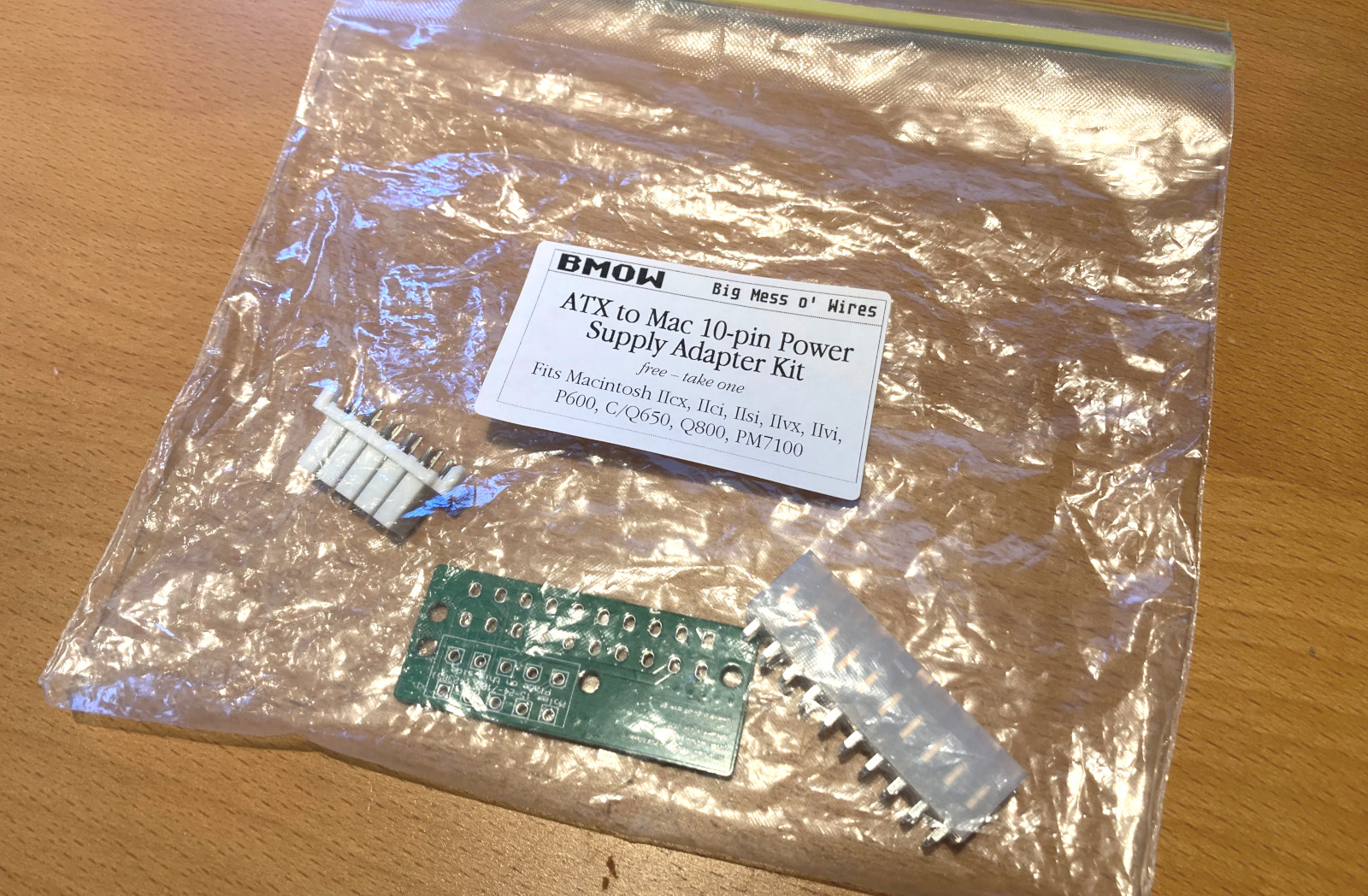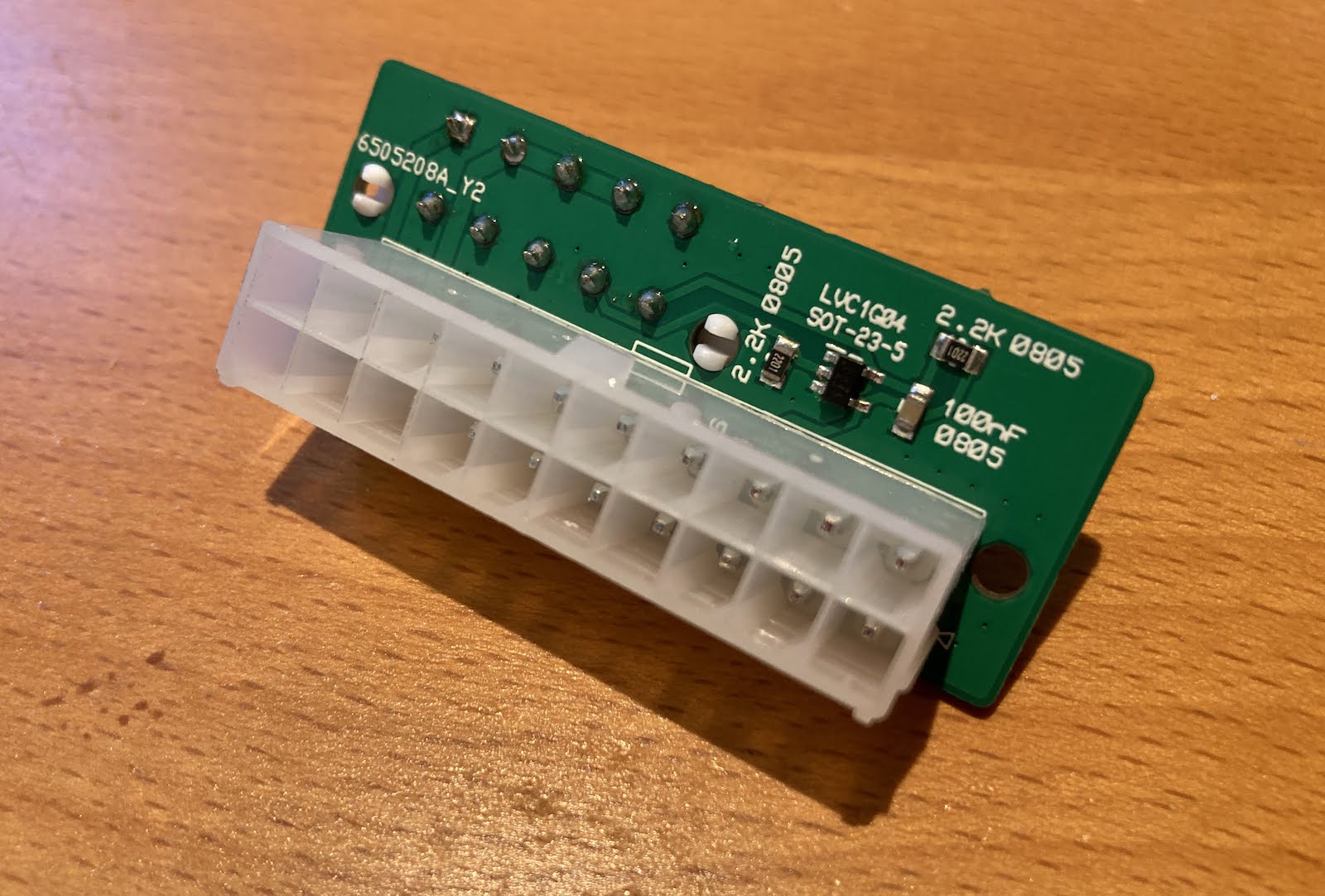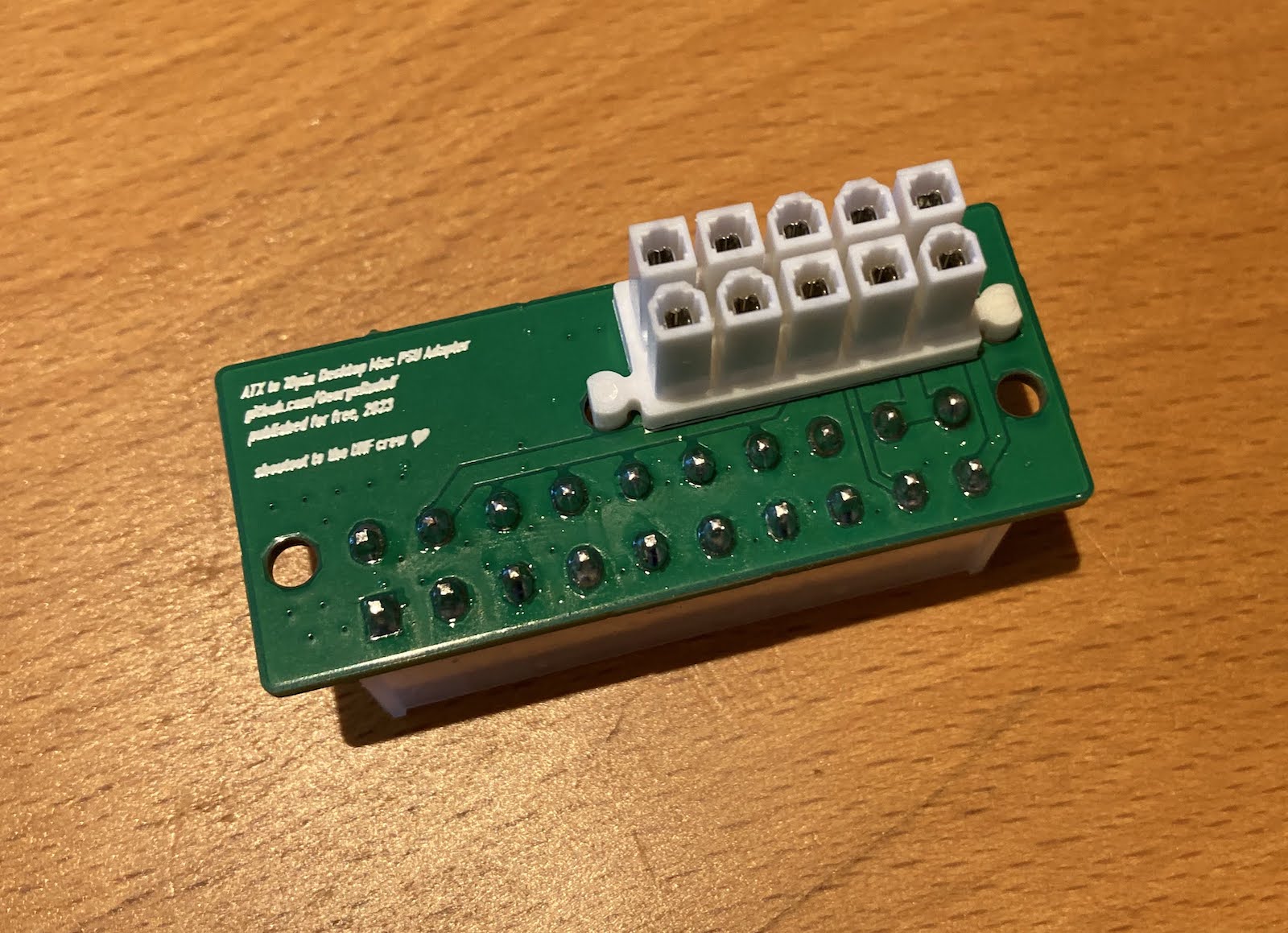ATX to Mac 10-pin Power Supply Adapter Kit

If you dabble with old computers, then you know the power supplies can fail just as often as the computers themselves. In the case of classic Macintosh computers, Apple didn’t use any kind of standard PSU, so buying new replacements isn’t possible. When a classic Mac PSU fails, the options are to recap and rebuild it, or make an adapter for another type of power supply. PC-style ATX supplies are cheap and readily available, and they offer the same +12V, +5V, -12V, and standby power outputs as Mac supplies. Wouldn’t an ATX-to-Mac PSU adapter be nice?
George Rudolf designed this simple ATX adapter and shared it on GitHub. It coverts a standard ATX 20-pin connector to the 10-pin connector found in the Macintosh IIcx, IIci, IIsi, IIvx, IIvi, Performa 600, Centris/Quadra 650, Quadra 800, and PowerMac 7100.


Aside from the different connectors, there’s also one small bit of active electronics on the adapter: an inverter for the ON signal. Classic Macs and PCs both support soft power, where the computer can be turned on from the keyboard or via software instead of with a hard on/off switch. This requires a power supply enable signal from a circuit using standby power, but the polarity of the ATX enable signal is the opposite of the Mac. Inverter to the rescue.
I was able to get 20 adapters assembled and shipped from JLCPCB for the princely sum of just $1.39 each. The connectors had to be sourced separately, but they’re readily available. Soldering the connectors only takes a few minutes, and they’re easy through-hole components.
I put together one of the 20 kits and installed it in my Macintosh IIci, and it worked great. I think it’s more useful for bench testing purposes than as a full PSU replacement, unless you want to go the extra mile of fashioning custom brackets to secure the ATX PSU inside the case.
For people who are attending Mactoberfest Meetup on October 14, I’ll have nineteen more of these ATX-to-Mac kits as free give-away items. You can assemble the kit right there at the meetup’s repair/work center. One of the Mactoberfest computer demos will also be a Mac IIci powered by an external ATX PSU, so you can see this adapter in action. I hope you enjoy these!

7 Comments so far
Leave a reply. For customer support issues, please use the Customer Support link instead of writing comments.


Depending on the power requirements of the Mac, a Pico PSU might also do the job instead of a regular ATX PSU.
The Pico PSU should not need a mounting bracket. All it needs is a regular DC jack that just needs a simple, round hole in the case, and an external single-voltage DC supply. The DC jack might fit into an unused slot bracket.
Because this adapter removes the need for the Apple PSU, it can be removed, leaving a lot of room for the DC supply or even more room for the DC jack in place of the original AC jack.
+1 for the PicoPSU recommendation.
I’m running a Q650 and a IIsi with a PicoPSU and a homebrew equivalent of this board; both work fine.
I’ve looked at the circuit at the github page of George Rudolf.
The circuit is designed for an open collector / open drain inverter, but the SN74LVC1G04DBVR has a push-pull output. So R2, the pull-up resistor at the inverter’s output, can be omitted.
Even better, the ATX spec () accepts an open collector / open drain signal for the PS_ON# signal and specifies a pull-up resistor to +5V in the PSU. So, R2 can be omitted twice. 😉
The input pull-down R1 is a good idea, it will keep the ATX PSU off even when the adapter board is disconnected from the Mac. Given the CMOS input of the inverter, the value of R1 can be increased by one or two decades (22 k, 220 k). It really does not matter.
A look at some reverse-engineered schematics (made by Bomarc) for the Mac II ci, cx, fx, and si shows only two main variants of the circuit for the PSU control line. Either a push-pull pair of transistors (most models) or a 68HC05 microcontroller output pin (which is always push-pull).
That makes me think that the relatively complex SN74LVC1G04DBVR is not really needed. It does not hurt, but it is way better than needed, and costs a few cents more than needed.
A simple universal n-Channel MOSFET (e.g. 2N7002) should be sufficient. Connect the gate of the MOSFET to the input signal from the Mac, the source to GND, and the drain to the PS_ON# signal from the ATX PSU. Keep R1 to ensure the PSU is kept off without the Mac connected to the adapter. Don’t leave the MOSFET’s gate electrode floating, it will collect charges from everywhere and cause strange behaviour. C1 is not needed with a MOSFET. A typical value for R1 would be about 10 kOhm to 100 kOhm.
You could also use a universal NPN transistor (e.g. BC546, BC846, 2N2222) instead. Connect the base via a new resistor of about 4.7 kOhm to the signal from the Mac, connect the emitter to GND and the collector to the PS_ON# signal from the ATX PSU. As before, you should keep R1 at the signal from the Mac. C1 is not needed with an NPN transistor.
The 2N7002, 2N2222, and BC546 are all available in through-hole technology, as are the resistors. So, using a 2N7002 reduces the BOM to just a (modified) PCB, two connectors, a resistor and a 2N7002, and if you want, no SMD components at all. Using a BC546/2N2222 needs another resistor.
Variations of the exact circuit you’ve re-derived have been floating around since the early nineties, at the latest.
The variation I’ve been using is https://github.com/Blackbird128/MacATX … one 2N2222, two resistors, two connectors, done. Note that Louis accidentally reversed the resistors (the 10k should be 1k and vice-versa); as you note, the exact values are not important so long as the ratio is more or less the same.
Speaking of picoATX power supplies, does anyone have a good idea of how much -12V supply is really needed for a Mac? The Apple supplies are rated at 1A and 0.6A for the -12V rail, the picoATX supplies are a lot lower, 0.2A or less. Looking at the Bomarc schematic for the Iicx, the only thing I spotted that used the -12V supply was the serial ports, the floppy drive and (maybe) nubus cards.
I believe the Mac uses very little from -12V, perhaps a few tens of milliamps. I’ve actually been researching this exact question recently, looking at the Mac IIci and IIcx. One thing you may have missed is that the Mac’s internal -5V rail is derived from the -12V supply with a 7905 linear regulator, so you need to sum the Mac’s demand from both -5V and -12V to estimate how much -12V the PSU must provide.
The 7905 -5V regulator itself has a quiescent current of 6 mA.
The two serial ports (printer and serial) use -5V, but for communication and not power. Looking a the circuit for a PhoneNet LocalTalk adapter, the -5V signals are driven through two parallel resistors (10K and 1K), so the current will be about 5.5 mA. I’m not sure about other serial devices but it’s probably similar. Call it 20 mA per serial port if you want to allow for some headroom.
The floppy drives theoretically use -12V, except they actually don’t. None of the standard 1.44MB floppy drives use -12V. If you look at the IIci schematic, you’ll also notice that -12V is only connected to the *external* floppy port, not the internal. I think this was simply a holdover from the Apple II days and an allowance for a possible future external floppy device that needed -12V. But no such future device was ever created. For Apple II drives that do need -12V it’s only used as a reference and the current is about 2.5 mA.
NuBus slots are supplied with -12V but not -5V. But I’ll wager that no NuBus cards actually use -12V for the same reason the Mac itself doesn’t – it’s just not needed for most chips and designs from that era. Maybe if you have a NuBus card that adds extra serial ports, or that does something exotic, then you might see some -12V load. But for typical NuBus cards like ethernet and video and accelerators, no.
Add those all up, and you get a total -12V demand of perhaps 50 mA at most.
Watch out for errors in BOMARC schematics. They are mostly reliable, but not infallible. Their IIcx schematic shows a 19V supply input. Their IIci schematic shows that the hard drive uses -12V. Neither is true.
is there anyway to buy this kit or ready adapter anywhere?